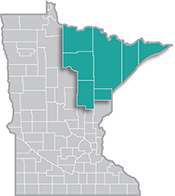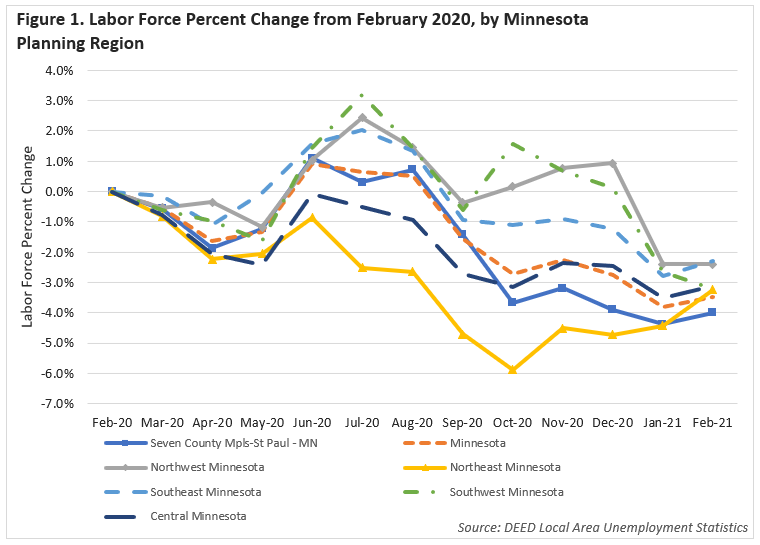 Home to the state's second-largest metro, the Northeast Region has a strong industrial sector, tied largely to the area's abundant natural resources.
Home to the state's second-largest metro, the Northeast Region has a strong industrial sector, tied largely to the area's abundant natural resources.
Most of the manufacturing base centers on mining and forest products industries. More than half of the sector's employment is in paper and machinery manufacturing.
Want the freshest data delivered by email? Subscribe to our regional newsletters.
4/29/2021 9:00:00 AM
Carson Gorecki
Traditionally, unemployment – specifically the unemployment rate – has been the measure of choice when assessing the overall health of the economy and labor market. The drastic changes we've seen occur in the labor market over the past year are a good reminder that the usual unemployment rate is not always the best tool for the job of describing the pandemic's unique impacts on our economy.
The terms "workforce" and "labor force" are often used interchangeably. However, the labor force has a specific definition as determined by the Bureau of Labor Statistics. The BLS defines the civilian labor force as "all people age 16 and older who are classified as either employed and unemployed." More generally, the labor force consists of people who are either working, or not working but looking for work actively. The labor force is a broader measure of the availability of workers and the surplus labor available to become employed.

Recently, the labor force has received more attention simply because it declined so significantly during the last year. Historically quite stable, the statewide labor force shrank by nearly 120,000 workers or about -3.8% during the pandemic recession. In Northeast Minnesota, the decline of the labor force was even greater and continued through last October, when it was -5.9% lower (-9,700 workers) than in February 2020 (see Figure 1). As of February 2021, the labor force was still -3.3% lower than a year previously.
Perhaps even more remarkable is that prior to 2020, the last time Northeast Minnesota's labor force averaged under 160,000 workers annually was 1998, when fewer people lived in the region. For the final six months of 2020, Northeast Minnesota saw the largest labor force declines relative to February 2020 levels.
During the Great Recession there was a sharp increase in Northeast Minnesota's labor force, due to formerly stay-at-home spouses joining the labor market when the other spouse was laid off but actively looking for work, as well as more people working until they were older instead of retiring. This sharp increase was followed by two years of a corresponding decline. So far, the current pandemic-induced recession has instead resulted in a steep decline in the size of the labor force (see Figure 2).

There are many reasons why a worker would choose to stop looking for work and leave the labor force. Perhaps the best-known means of exiting the labor force is retirement, typically as older workers decide to call it a career. DEED's Profile of Risk for Prolonged Unemployment shows that older workers were more likely to be unemployed for longer during the pandemic, which could lead to higher rates of discouragement or marginal attachment. Individuals are considered to be marginally attached to the labor force if they are unemployed and not currently looking for work but indicate that they are interested in working. The marginally attached are considered discouraged if there is a specific barrier to their being able to find work, such as believing no job is available to them in their field or location, discrimination, or the lack of necessary training or experience. (See Ways Unemployment Is Measured, below.)
Another reason pulling workers from the labor force is the need to take care of family members. Schools and childcare facilities were subject to pressures they did not face during previous recessions. Families had to scramble to care for children, often choosing to stay home to do so themselves, further constraining the supply of workers. Women more often fill the role of primary caretaker and were more likely to leave the labor force for this reason.
Lastly, some workers may have stopped looking for work for fear of being exposed to the virus itself. Stimulus payments and additional unemployment benefits made staying home a more viable option, at least in the shorter term, but concern for one's health has proven to be a major factor in workers' decisions to not look for work.
Whatever the reason, there are fewer people looking for work now than there were prior to the pandemic. Whether the decrease in the labor force is temporary will be crucial to the economic recovery of Minnesota, but especially in Northeast Minnesota where the labor force has been stagnant or declining for more than a decade.
The official unemployment rate that we publish every month – also known as the U-3 rate - represents a subset of the labor force that has not worked in the last week but has looked for work in the past month. The U-3 unemployment rate is the most commonly used measure of unemployment, but is one of six ways unemployment is measured. The measures range from the narrowest (U-1) to broadest definitions of unemployment (U-6).
Each month DEED's Labor Market Information Office publishes the official U-3 rates, but also releases Alternative Measures of Unemployment for the state, which includes measures of discouraged workers and the long-term unemployed. The 12-month rolling average U-3 rate for Minnesota in March 2021 was 6.2%. For comparison, the U-6 rate in March was 10.8%.
Contact Northeast Minnesota Labor Market Analyst Carson Gorecki at 218-302-8413.